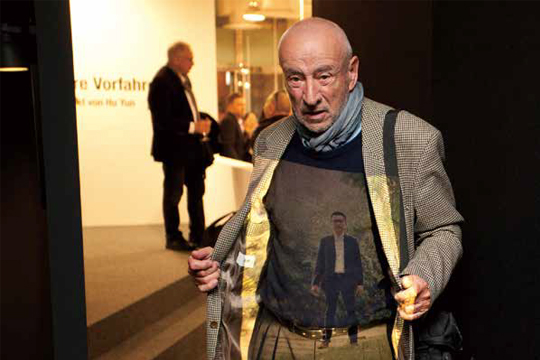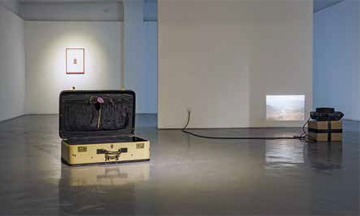HU YUN: TRAVELING ON THE SHIP OF FOOLS
| August 26, 2013 | Post In LEAP 22

Hu Yun is neat and self-controlled, calm and collected. He seems to be the antithesis of a madman, yet he uses Foucault’s notion of “the ship of fools” to explain his practice. In the Middle Ages, people would use these endless maritime voyages to exile madmen, in part to restore the peace, and in part so that the insane might find their sanity during their pilgrimage. In the context of his art, the “ship of fools” sets the countless thoughts swirling around his mind adrift, floating along a boundary line flickering in and out of sight. Occasionally it docks on the shore, as if it were a form of self-psychoanalysis. After graduating from the China Academy of Art’s School of Intermedia Art in 2008, Hu chose to stay in Shanghai to evade contamination from the effects of education, art cliques, and market influences. Despite this, one can still see the influence of his professor Qiu Zhijie’s Total Art Studio—often working from investigatory research, appropriating and reassembling primary texts and visual materials according to an individual sensibility and overarching historical perspective, with noticeable interventionist characteristics. Hu is vigilant against these methodologies, using the process of artistic creation itself as a means of self-curation. He is adept at mobilizing various personal and historical experiences, incorporating previously produced materials into his artworks. That is to say, it is impossible to consider any of Hu’s works in isolation. They all share a common theme, an element of foreshadowing, all interconnected.
In 2010, Hu Yun was invited to spend three months at Gasworks in England investigating the collection of the Natural History Museum. It was here that he learned about the amateur naturalist John Reeves, who from 1812 to 1831 took up residence in China. Reeves once commissioned Chinese draftsmen to produce over 2,000 watercolor drawings of species native to China. There exist exhaustive records about Reeves himself, yet scarcely anything remains concerning the identity of these draftsmen. Hu was interested in what this story reveals about modern China and colonial history, and was skeptical of this sort of “cherry-picked” history. From these investigations he produced his Memorialize Memory. He used two wood monumental slabs, identical in dimension, to rectify this history— on one slab he carved a biography of Reeves, and on the other he projected a video of different names (including his own) being continuously effaced. The artist also donated a watercolor work he created during his residency period to the Natural History Museum to be stored anonymously along with Reeves’ collection. The artist himself became an extension of these memories.
For his work in the fourth Guangzhou Triennale Secret Garden I: The Reeves’s Pheasant, Hu Yun used Reeves’ history to conduct a language game. The English name of a species of pheasant native to China now bears Reeves’ name. This animal also symbolizes a romantic and exoticized fantasy of the East (“Chinese people like grotesque oddities…”), which is a specter that looms over the entire exhibition, impossible to dispel. Hu uses art to respond to this mode of natural history research, transforming modern civilization into a garden of mystery.
Hu Yun sees artistic production and exhibition as an indivisible whole. From the background information of each artwork to the methods of exhibition, Hu works as if he were a curator. In the show “Alternatives to Ritual” at the Goethe-Institut, Hu once again uses the museum as a locus for discussion, presenting his individual project “Our Ancestors” within this relatively independent space. Sharing its name with a trilogy of novels by Italo Calvino, the personages in the work are seemingly unrelated: one is the industrialist founder of China’s first private museum, Zhang Jian (1853-1926), a representative of modern Chinese elite culture and a figure relevant to the work’s institutional context; the other is an old Shanghainese man born in 1925 (Hu’s paternal grandfather) who personally experienced the transformation of modern civilization that Zhang Jian eagerly anticipated. With a beam of light, the artist also projects a photograph of himself onto the viewer’s body, searching for a place for himself (a young man).

The backstory of Hu Yun’s most recent solo exhibition at Aike-Dellarco “Lift with Care” comes from two fateful journeys. On a machine-embroidered roadmap, abstract lines and dots record the failed 1908-1909 journey of a foreign scientific investigation team to western China. The investigative team included missionaries, naturalists, and colonists. As such, to a certain extent, they were not merely travelers. Originally, they planned to set out from Taiyuan and cross Shaanxi and Gansu, head to Sichuan by way of Tibet, then take the Yangtze River down to Shanghai before finally returning to America. However, because one of their members died under strange circumstances during the trip, they were forced to suspend their journey only a third of the way through. An antique suitcase sitting open in the exhibition space, a pile of rubbings of the Nestorian Stele (a stele commemorating Christianity’s introduction into China), and an air-dried peony all act as memorials to this period of history. In another section, Hu Yun compiles a number of conversations with his grandfather. Among them is one memory from his grandfather’s youth that brings Hu back to his grandfather’s hometown to revisit these old landscapes. The photos he shot during the journey are projected frame-by-frame into the exhibition space.
Hu Yun takes explorations and journeys in different times and locations and places them within a multilayered narrative framework, directly appropriating and rearranging historical materials. By overlaying the “crossing of Shaanxi and Gansu” adventure, itself representative of modern Western civilization, with his own grandfather’s flight during modern China’s revolutionary period, Hu creates an extension of history. To avoid any single concrete subject, once the artist has created a unified textual foundation for his work, he departs from the source narrative. As a supplement to or complication of the two source texts, Hu also adds an oral component to the exhibition. In a corner space one can ring a bell, calling a gallery attendant over to recite a fairy tale written by the artist. Through combining such a range of readymades, documents, and images, Hu reveals the indivisibility of individual experience, story, and historical event from their immediate context. The past and present, individual and public constantly influence one another.
The blending of private emotions and the memories of another underpins many of Hu Yun’s recent exhibitions. His grandfather’s memories repeatedly pop up as the source material for his projects, yet his handling of these memories is not simply heterotopic. Hu instead sees a more multifaceted self, while also searching for a historical grounding for a generation that had none. With his art, the artist seeks a perspective by which he might establish links between himself and history. His practice is similar to that of Simon Fujiwara, which combines fragments of personal history with those of human history. His works’ indictment of colonial history and Western cultural control is noticeably much milder than in the works of Danh Vo. Hu does not adopt materialist methods to approach topics of modern colonial history and revolution; rather, he uses different personages to unpack their separate histories. Those connections, seemingly both meaningful and meaningless, function like a novel, endowed with rationale by its narrative.
Even though Hu Yun’s works always leave significant scope for the viewer, they do not explicate much of their own backstories. It takes detective-like observation and deduction to discover all the minutiae within his works, and even then it is difficult to discern their real significance. Hu prefers to conduct this sort of test. He deliberately creates entrance points into his works as an invitation, hoping the viewer will use his or her own experience to make connections within the piece. If one wants to discern these flickering memories hidden in the darkness, perhaps a better way would be to simply board the ship with him, drifting on the waterways that draw infinitely closer to Hu’s spiritual kingdom, to capsize alongside the logic of the ship of fools. (Translated by Patrick Rhine)

